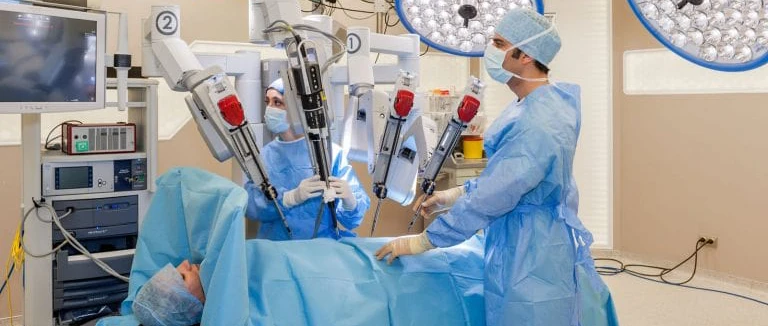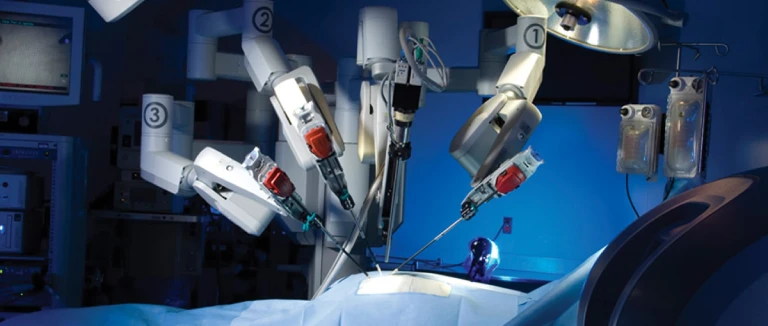What is Robotic Surgery?
Robotic surgery is a minimally invasive surgical technique that uses robotic systems to assist surgeons in performing complex procedures with enhanced accuracy. The technology allows for smaller incisions, greater control, and improved visualization compared to traditional surgery.
During a surgery procedure, the surgeon operates from a console, controlling robotic arms equipped with surgical instruments and a high-definition 3D camera. The system replicates the surgeon’s hand movements in real time but with greater steadiness and precision. This enables delicate operations that would be difficult to perform manually.
In Turkey, robotic surgery is widely used in specialties such as urology, gynecology, general surgery, cardiology, and orthopedics. Hospitals like Liv Hospital have been pioneers in adopting advanced robotic surgery technologies to enhance surgical outcomes and patient safety.

The Evolution of Robotic Surgery
Surgery first gained recognition with the introduction of the da Vinci Surgical System, which revolutionized the field of minimally invasive surgery. Over the years, technological advancements have made robotic systems more refined, versatile, and accessible.
In Turkey, the adoption of surgery has grown rapidly due to the country’s commitment to healthcare innovation. Leading institutions such as Liv Hospital continuously invest in advanced robotic platforms and surgeon training programs to ensure the highest standards of medical care.
Why Robotic Surgery in Turkey ?
Turkey has become a preferred destination for patients seeking surgery because of its combination of medical expertise, advanced technology, and cost-effectiveness. The country’s hospitals adhere to international quality standards and employ highly trained specialists who perform robotic surgeries with remarkable success rates.
Liv Hospital is among the few hospitals in Turkey offering comprehensive robotic surgery programs across multiple medical specialties. The hospital’s dedication to innovation, patient safety, and personalized care has positioned it as a leader in robotic-assisted procedures.
1. Enhanced Precision and Control
One of the most significant advantages of surgery is the enhanced precision it provides. The robotic arms can move in ways that exceed the natural range of motion of the human hand. This allows surgeons to perform intricate movements with absolute steadiness, reducing the risk of human error.
The 3D high-definition view offered by robotic systems gives surgeons a magnified view of the surgical field. This level of detail enables precise dissection and suturing even in hard-to-reach areas. Liv Hospital’s surgical teams use advanced robotic systems that ensure the utmost accuracy during delicate procedures such as prostate removal, hysterectomy, and heart valve repair.
2. Smaller Incisions and Minimal Scarring
Robotic surgery is minimally invasive, meaning it requires only small incisions to insert surgical instruments. These smaller incisions result in minimal scarring, less tissue damage, and faster healing compared to open surgery.
Patients who undergo surgery at Liv Hospital often experience significantly less postoperative pain and quicker recovery times. The reduced scarring not only improves cosmetic results but also minimizes the risk of wound infections.
3. Reduced Blood Loss and Faster Recovery
Because surgery involves smaller incisions and more controlled movements, it typically causes less bleeding during the operation. This reduces the need for blood transfusions and decreases the risk of complications.
Patients recover faster and can return to their normal activities much sooner. In many cases, hospitalization time is shortened, allowing patients to go home within a few days. Liv Hospital emphasizes rapid recovery protocols and personalized rehabilitation programs to help patients resume daily life as quickly and safely as possible.
4. Shorter Hospital Stay
One of the key benefits of surgery is a shorter hospital stay. Traditional open surgeries often require long recovery periods in the hospital, while robotic-assisted procedures significantly reduce inpatient time.
Patients who choose Liv Hospital for robotic surgery benefit from the hospital’s advanced postoperative care facilities, where a dedicated team of medical professionals monitors recovery closely. This ensures that patients receive continuous care, comfort, and support from surgery to discharge.

5. Greater Surgeon Comfort and Efficiency
Robotic surgery also benefits surgeons by providing improved ergonomics and control. The surgeon operates while seated at a console, reducing physical strain and fatigue. This allows for better focus and precision throughout lengthy procedures.
Liv Hospital’s surgical teams are extensively trained to use robotic systems efficiently, ensuring optimal performance and safety. The combination of surgeon expertise and robotic technology results in superior surgical outcomes.
6. Lower Risk of Complications
The precision of robotic surgery minimizes tissue trauma and reduces the likelihood of postoperative complications such as infections or excessive bleeding. This is particularly beneficial for patients undergoing complex or high-risk procedures.
Liv Hospital’s robotic surgery units are equipped with advanced safety features and monitoring systems to ensure maximum control during every step of the operation. With these innovations, patients can feel confident about the safety and reliability of their surgical experience.
7. Broader Range of Procedures
Robotic surgery can be used across many medical specialties. In Turkey, robotic technology is applied in urology, gynecology, cardiovascular surgery, thoracic surgery, and orthopedics. Common procedures include prostatectomies, hysterectomies, gallbladder removal, cardiac valve repair, and joint replacements.
Liv Hospital’s robotic surgery departments specialize in diverse fields, making it one of the few hospitals in Turkey capable of performing such a wide range of robotic-assisted procedures. Each department works collaboratively to develop tailored treatment plans based on each patient’s unique condition and needs.
Robotic Surgery at Liv Hospital
Liv Hospital has established itself as a center of excellence in robotic surgery. Equipped with advanced robotic systems and a multidisciplinary team of surgeons, Liv Hospital provides a safe and precise surgical environment for patients from Turkey and abroad.
The hospital’s robotic surgery units utilize the latest technology, including high-definition imaging and real-time motion control systems. These innovations allow surgeons to perform complex operations with unprecedented accuracy. Liv Hospital’s dedication to patient care extends beyond surgery, offering preoperative counseling, postoperative rehabilitation, and continuous follow-up.
International patients particularly appreciate Liv Hospital’s seamless healthcare experience, which includes translation services, airport transfers, and personalized medical coordination. The hospital’s International Patient Services Department ensures that every stage of the journey is comfortable and stress-free.
Why International Patients Prefer Liv Hospital for Robotic Surgery ?
Liv Hospital is renowned among international patients for combining medical expertise with hospitality. The hospital provides advanced robotic surgery at competitive prices without compromising on quality or safety. With internationally accredited standards and a patient-focused philosophy, Liv Hospital remains one of the top destinations for robotic surgery in Turkey.
The hospital’s multilingual medical team communicates clearly with patients, explaining each step of the surgical process and recovery plan. This transparency helps patients feel informed and confident throughout their treatment.
The Future of Robotic Surgery in Turkey
As technology continues to evolve, robotic surgery will play an even more significant role in modern medicine. Turkey is investing heavily in healthcare innovation, making robotic-assisted procedures increasingly available across the country. Liv Hospital leads this transformation by adopting the newest surgical technologies and training surgeons in the latest techniques.
With a growing global reputation for medical excellence, Turkey and Liv Hospital are at the forefront of robotic surgery advancements. Patients seeking minimally invasive, safe, and efficient treatments will continue to benefit from the country’s commitment to healthcare innovation.
Conclusion
Robotic surgery represents the future of precision medicine, offering unparalleled accuracy, safety, and comfort for patients. Turkey has become one of the world’s leading destinations for robotic surgery, attracting thousands of patients seeking high-quality, affordable care.
Liv Hospital stands as a pioneer in this field, combining advanced technology, world-class medical expertise, and compassionate patient care. From shorter recovery times and smaller scars to higher surgical success rates, the benefits of robotic surgery at Liv Hospital are clear. Choosing Liv Hospital means choosing innovation, safety, and excellence in healthcare.
For more information about our academic and training initiatives, visit Liv Hospital Academy
* Liv Hospital Editorial Board has contributed to the publication of this content .
* Contents of this page is for informational purposes only. Please consult your doctor for diagnosis and treatment. The content of this page does not include information on medicinal health care at Liv Hospital .
Frequently Asked Questions
What is robotic surgery?
Robotic surgery is a minimally invasive technique where surgeons use robotic systems to perform complex procedures with greater precision, smaller incisions, and faster recovery.
How does robotic surgery work?
During the procedure, the surgeon controls robotic arms from a console. These arms hold surgical instruments and a 3D camera, replicating the surgeon’s movements with higher accuracy.
What are the advantages of robotic surgery?
It offers enhanced precision, smaller scars, less bleeding, faster recovery, and shorter hospital stays compared to traditional surgery.
Is robotic surgery safe?
Yes. Robotic surgery is designed to improve safety by reducing human error and tissue damage. All procedures are performed under the surgeon’s full control.
What types of procedures use robotic surgery?
It is widely used in urology, gynecology, general surgery, cardiology, thoracic surgery, and orthopedics for procedures such as prostate removal, hysterectomy, and valve repair.
How long does recovery take after robotic surgery?
Most patients recover more quickly than after open surgery and can often return to normal activities within a few days.
Why is Turkey preferred for robotic surgery?
Turkey offers advanced technology, experienced surgeons, and affordable prices. Hospitals like Liv Hospital provide international-standard robotic surgery programs.
What makes Liv Hospital a leader in robotic surgery?
Liv Hospital combines cutting-edge robotic systems with expert surgeons, personalized care, and world-class facilities for safe and successful outcomes.
What is the future of robotic surgery in Turkey?
With continuous investment in innovation and training, robotic surgery is rapidly expanding in Turkey. Liv Hospital remains at the forefront, pioneering new surgical technologies and techniques.



